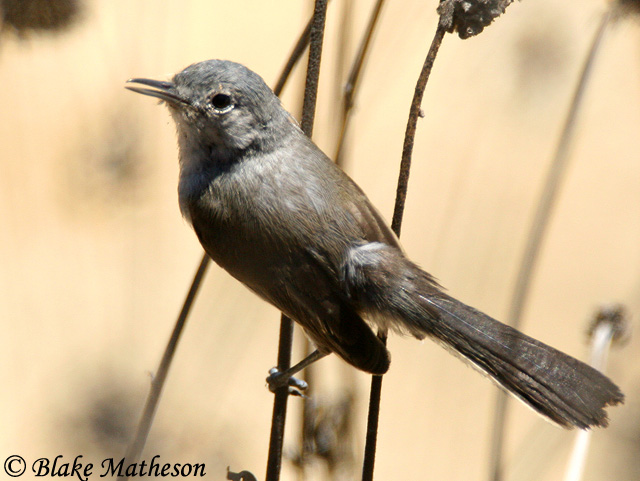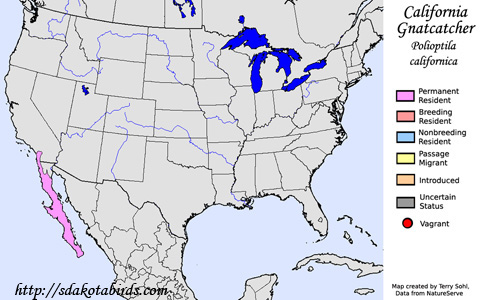| Length: 4.5 inches | Wingspan: 5.5 inches | Seasonality: Non-resident in South Dakota |
| ID Keys: Gray overall, black tail with minimal white, faint white eye-ring, dark cap on male in breeding plumage, more brownish tones than Blue-gray Gnatcatcher | ||
 The
California Gnatcatcher and the
Black-tailed Gnatcatcher were considered the same species until the late
1980s. There are plumage and voice differences between the two
species, with Black-tailed Gnatcatchers appearing paler overall and having
more white on the tail than California Gnatcatchers. Their preferred
habitat in the U.S. portion of their range is coastal shrublands consisting
of California sagebrush, salvia, prickly-pear cactus, and buckwheat, a
habitat that was relatively limited to begin with, and has been greatly
reduced due to urban development along the southern California coast.
In the United States, the California Gnatcatcher was listed as a "threatened
species" in 1993, under the Endangered Species Act. There has been some
controversy and court clashes between development groups, environmental
groups, and U.S. Fish and Wildlife over management of species, and proposed
development in their habitat.
The
California Gnatcatcher and the
Black-tailed Gnatcatcher were considered the same species until the late
1980s. There are plumage and voice differences between the two
species, with Black-tailed Gnatcatchers appearing paler overall and having
more white on the tail than California Gnatcatchers. Their preferred
habitat in the U.S. portion of their range is coastal shrublands consisting
of California sagebrush, salvia, prickly-pear cactus, and buckwheat, a
habitat that was relatively limited to begin with, and has been greatly
reduced due to urban development along the southern California coast.
In the United States, the California Gnatcatcher was listed as a "threatened
species" in 1993, under the Endangered Species Act. There has been some
controversy and court clashes between development groups, environmental
groups, and U.S. Fish and Wildlife over management of species, and proposed
development in their habitat.
Habitat: Found in coastal sage scrub in the California portion of their range. Found in a variety of scrubby habitats in the Baja California portion of their range.
Diet: Feeds on insects and spiders, but may also supplement the diet with fruits and berries at times.
Behavior: Moves quickly through the foliage of shrubs and other low vegetation in search of insects and spiders. They will also sometimes hover to glean insects from vegetation.
Nesting: The nest of a California Gnatcatcher is a small cup of grasses, weeds, leaves, spider webs, and other material, placed in a shrub, usually within 5 feet of the ground. The female lays between 3 and 5 eggs, and both parents help to incubate them. When the eggs hatch, both parents help to feed the young, who leave the nest after about 16 days.
Song: The song of a California Gnatcatcher is a series of mewing, sometimes harsh notes, with a pattern that rises and falls in pitch.
Migration: Considered a permanent resident throughout its range.
Interactive eBird Map: Click to access an interactive eBird map of California Gnatcatcher sightings
Similar Species: Most likely to be confused with the Black-tailed Gnatcatcher, Blue-gray Gnatcatcher, Black-capped Gnatcatcher
Conservation Status: Populations are decreasing due to habitat loss. In the California portion of their range, habitat loss has resulted in drastic declines in the species, and they are listed as a threatened species under the Endangered Species Act in the United States. However, they are still a relatively common species in parts of their Mexican range. On a global basis, the IUCN lists the California Gnatcatcher as a species of "Least Concern".
Further Information: 1) U.S. Fish and Wildlife Species Profile - California Gnatcatcher
2) Audubon Guide - California Gnatcatcher
3) California Partners in Flight - California Gnatcatcher
Photo Information: Photo taken by Blake Matheson - August 20th, 2008 - Near White Point in southern California - Photo licensed under Creative Commons Attribution NonCommercial 2.0 Generic License
| Click below for a higher-resolution map |
 |
| South Dakota Status: Non-resident in South Dakota |
Additional California Gnatcatcher Photos (coming soon!!)
